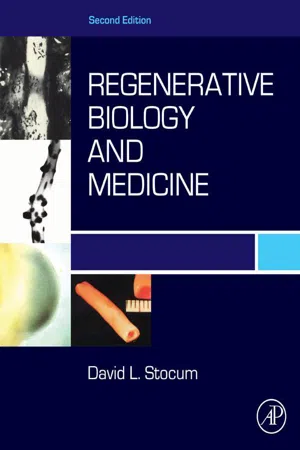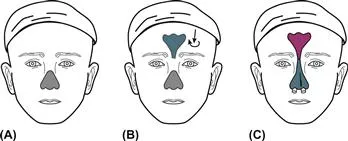II A Brief History of Regenerative Biology
Historically, regenerative biology has its roots in observations on the healing of wounds and of appendage regeneration (see Goss, 1991). Severe injuries such as penetrating wounds, multiple fractures, spinal cord compression, or damage to the eyes have occurred throughout the history of the human species, due to conflict and accidents. Testimony to the importance of wounds is found on the walls of Paleolithic caves, which bear the imprints of hands with amputated fingers. Early humans would have noted the kinds of wounds that were survivable and those that were not, and attempted rudimentary means to facilitate their repair. They were also likely to have been aware of the phenomenon of regeneration from observations on food animals such as crustaceans and deer, which can regenerate their legs and antlers, respectively. The fact that trees renew their leaves and seeds on a cyclical basis, and re-grow severed limbs in another direction would also have contributed to an awareness of, and curiosity about, regeneration.
Treatments to aid wound repair preceded by many millennia any knowledge of how the repair was actually accomplished. Methods to facilitate wound healing, including surgical interventions, were central to the medicine of ancient Sumerian, Egyptian, Chinese, Indian, and Inca civilizations (Majno, 1975; Brown, 1992; Falabella, 1998). The cleansing and debridement of wounds was a common practice in ancient cultures and many different vegetable and mineral concoctions were applied topically to treat wounds. The ancient Chinese and Egyptians used honey and wine as antiseptics and the Chinese have used a bread mold to treat minor burns for over 2000 years (Majno, 1975; Fu et al., 2001). Trephination to relieve intracranial pressure was performed by the Incas in the treatment of head wounds (Majno, 1975). A thousand years ago, as shown in Fig. 1.1, the Indian physician, Sushruta, described the use of autogeneic skin transplants to reconstruct severed noses and ears (Majno, 1975).
Figure 1.1 Autotransplant of forehead skin flap to reconstruct the nose, described by Sushruta ~1000 AD. The flap was cut to conform to the outline of a nose, peeled down and twisted 180° at the stalk (arrows). It was then positioned over the nasal area with the dermal side down and held in place with wooden rods until healed.
The Greek and Roman physicians Hippocrates (460–370 BC), Celsus (25 BC–50 AD), and Galen (130–201 AD) contributed greatly to the development of medicine, including the treatment of wounds (Brown, 1992). Part of Galen’s career was spent caring for injured gladiators, which gave him extensive experience in treating wounds to many parts of the body. Galen compiled virtually all that was known about anatomy, physiology, and medical treatment at the time (much of it erroneous) into at least 35 volumes. When the Western Roman Empire collapsed near the end of the 5th century AD, Galen’s texts were translated into Arabic, the language of medicine in the Eastern Roman Empire, and later from Arabic into Latin. These texts were the dominant guides for medical practice until the end of the Middle Ages.
A creative blossoming of biology and medicine took place from the 14th to the 17th centuries, based on more accurate and detailed observations of form and function. Major contributions were the anatomical descriptions of embryonic and adult structure made by Da Vinci (1452–1519), Vesalius (1514–1564), Paracelsus (1493–1541), Fallopius (1523–1562), and Fabricius (1537–1614). Descartes (1596–1650) and Borelli (1608–1679) wrote important texts on physiology, and Harvey (1578–1657) produced his famous treatises on the circulation of the blood and the reproduction of animals. The surgeon Guy de Chruliac (1300–1370) published “Wounds and Fractures” in 1363, a book that detailed many kinds of wounds and how to treat them. Wilhelm Fabry (1560–1634) described nearly 70 topically applied formulations for treatment of wounds, many of which have been re-examined and found to have true therapeutic value (Kirkpatrick et al., 1996).
The technological and conceptual revolutions that brought forth modern science took place in the 17th century. The technological revolution was the beginning of experimentation in chemistry and the development of the telescope and microscope, with new results and ideas being disseminated by the printing press, which had been invented two centuries earlier. The conceptual revolution began with a challenge to the Aristotelian view of the motion of celestial bodies, which were considered to move in perfectly circular orbits on invisible spheres (Van Doren, 1991). Kepler (1571–1630) showed that the planets moved in elliptical orbits and that the time required for each orbit was proportional to their distance from the sun. Galileo (1564–1630) proved mathematically what Copernicus had concluded a century earlier: that the earth orbits around the sun, not the reverse, which was the doctrinaire religious view of the time. Newton (1642–1727) related forces and motion in his three general laws of motion, now generally referred to as “Newtonian mechanics”. Descartes (1596–1650) generalized these physical and mathematical relationships into the philosophy of mechanism—that everything in the material universe, including organisms, could be treated as machines that behave according to strict mathematical laws of physics. In 1687, Newton published his “Mathematical Principles of Natural Philosophy”, in which he formalized four rules of reason to guide scientific investigation.
1. The best explanation for a natural phenomenon is the simplest one that is true and sufficient (William of Ockham’s razor).
2. The same causes should be assigned to the same natural effects (inductive reasoning).
3. Those qualities common to all objects or phenomena within our realm of experience are assumed to be universal (deductive reasoning).
4. The most important rule of all: accept no explanations not directly supported by observation or experiment.
These rules provided a powerful way of answering questions about how things work, changing our view of the world forever.
In biology, the invention of the compound microscope in the early 1600s made it possible to view biological structure in greater detail than ever before and thus better understand the nature of biological phenomena. This technological leap forward led to development of the science of microscopic anatomy in the 18th century. The comparative anatomist John Hunter (1728–1793) studied healing skin wounds and discovered granulation tissue and the transitional role it played in scar tissue formation (Brown, 1992). The dogma of preformation, which held that the mechanism of ontogeny was the growth of a tiny pre-delineated adult within the egg, was toppled by the studies of C.F. Wolff on chick embryos, which showed that the embryo developed by a series of epigenetic steps that built form out of amorphous substance.
The 19th century saw numerous medical and surgical advances that improved the prospects of recovery from serious injury and disease (Allan, 1977). The development of ether anesthesia made pain-free surgery possible and thus increased the types of surgical interventions that could be made in the human body to treat different conditions. Surgery, however, also increased the possibility of death by systemic bacterial infection. Joseph Lister, a student of Pasteur, introduced the use of dressings soaked in carbolic acid and strict hygienic measures in hospitals to combat sepsis after surgical operations (Brown, 1992). Nineteenth century surgeons revived the techniques of skin grafting described by Sushruta many centuries earlier (Majno, 1975).
The most significant development of the 19th century for the future of biology and medicine, however, was the rise of materialistic biology, which was an outcome of Descarte’s philosophy of mechanism. Until the mid-18th century, it was thought that the properties of life forms were due to an immaterial vital force, not the material chemical and physical forces that regulated the properties of inanimate objects (Coleman, 1977). However, experiments begun by Lavoisier (1743–1794) in the second half of the 18th century and carried on by others into the 19th century showed that life depended on chemical reactions that were reproducible in the laboratory. With the formulation of the cell theory by Schleiden and Schwann in 1838–1839 and the later microscopic observations of Virchow, Remak and others, it became clear that cells are the fundamental units that carry out the chemical reactions of life and that new cells are created by the division of existing cells, thus explaining growth and reproduction.
The 20th century saw an unparalleled explosion of biological and medical knowledge. Major advances were the discovery and production of antibiotics, the development of molecular replacement therapies for diseases su...

